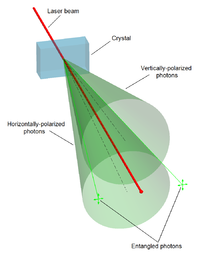
Photo from wikipedia
In this work, we explore the feasibility of performing satellite-to-Earth quantum key distribution (QKD) using the orbital angular momentum (OAM) of light. Due to the fragility of OAM states the… Click to show full abstract
In this work, we explore the feasibility of performing satellite-to-Earth quantum key distribution (QKD) using the orbital angular momentum (OAM) of light. Due to the fragility of OAM states the conventional wisdom is that turbulence would render OAM-QKD non-viable in a satellite-to-Earth channel. However, based on detailed phase screen simulations of the anticipated atmospheric turbulence we find that OAM-QKD is viable in some system configurations, especially if quantum channel information is utilized in the processing of post-selected states. More specifically, using classically entangled light as a probe of the quantum channel, and reasonably-sized transmitter-receiver apertures, we find that non-zero QKD rates are achievable on sea-level ground stations. Without using classical light probes, OAM-QKD is relegated to high-altitude ground stations with large receiver apertures. Our work represents the first quantitative assessment of the performance of OAM-QKD from satellites, showing under what circumstances the much-touted higher dimensionality of OAM can be utilized in the context of secure communications.
Journal Title: Physical Review Applied
Year Published: 2020
Link to full text (if available)
Share on Social Media: Sign Up to like & get
recommendations!